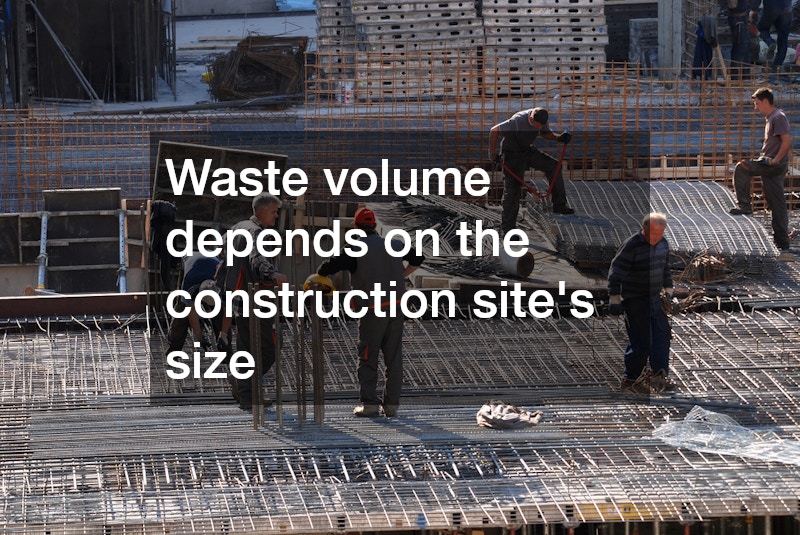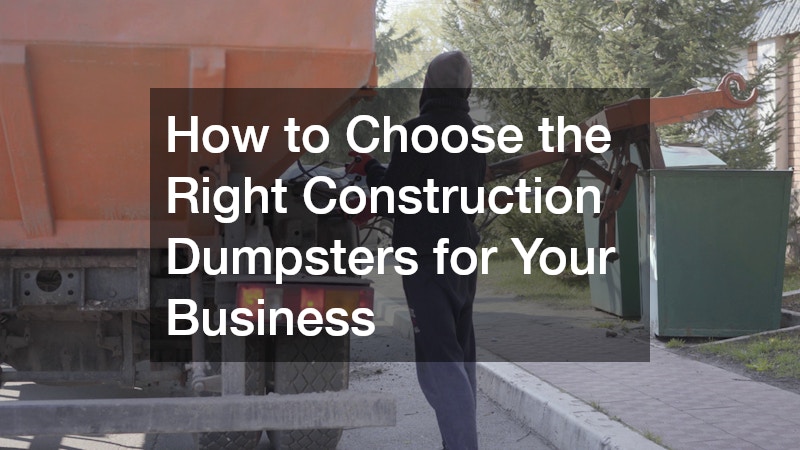Selecting the right construction dumpsters for your business is crucial in managing waste efficiently on any job site. Proper waste disposal helps keep your project organized and safe and contributes to environmental responsibility and cost control. Construction projects generate various types of debris, from wood and concrete to metals and packaging materials, all requiring appropriate handling.
Choosing the right dumpster involves understanding the nature of the waste, the size and scope of your project, and regulatory requirements that may apply to your area. Making informed decisions about dumpster rental can save time, reduce expenses, and promote a smoother workflow.
Business owners must weigh factors such as dumpster size, rental terms, and compliance with local regulations when choosing a dumpster. A too-small dumpster can lead to overflow issues, creating safety hazards and additional disposal fees. Conversely, selecting a too-large dumpster may result in paying for unused capacity. Additionally, rental agreements often vary in duration, weight limits, and permitted materials, making it essential to review the terms carefully. Finally, local ordinances or homeowners’ association rules might restrict dumpster placement or disposal methods. By carefully considering these aspects, businesses can optimize their waste management process and ensure their construction sites remain compliant and efficient.
Understanding Construction Dumpster Types
Construction dumpsters are designed to handle different waste materials and project requirements. These dumpsters can range from roll-off containers to front-load dumpsters, each serving unique purposes depending on the scale and nature of the job. Understanding these types is fundamental in choosing the correct container to accommodate the debris generated. Some dumpsters are specifically designed for heavy materials like concrete and asphalt, while others cater to lighter materials such as wood and packaging waste. This variety ensures businesses find a dumpster that matches their needs without overspending or underutilizing the container.
Roll-off dumpsters are among the most commonly used in construction because of their large capacity and ease of loading bulky debris. They typically range in size from 10 to 40 cubic yards and are delivered to the job site via trucks with a hydraulic lift. Front-load dumpsters, on the other hand, are smaller and often used for ongoing waste disposal in smaller-scale projects or commercial settings. Specialized dumpsters may also be available for hazardous waste or recyclable materials, helping companies stay environmentally compliant. Knowing the types of dumpsters available allows businesses to select containers that best fit their waste profile and project scope.
Assessing Your Project’s Waste Volume
Estimating the volume of waste your project will produce is one of the most essential steps in choosing the right dumpster. Waste volume depends on the construction site’s size, the project’s duration, and the materials being removed or installed. A thorough assessment helps prevent problems such as frequent pickups or overfilled containers, which can delay work and increase costs. By clearly understanding the expected waste output, businesses can select a dumpster size that optimizes both price and convenience.
To get more specific, calculating waste volume involves reviewing project plans and timelines, and considering factors like demolition debris, packaging materials, and excess building supplies. For instance, a kitchen remodel may generate less waste than a complete home demolition, requiring a smaller dumpster. Many dumpster rental companies provide guidance or waste calculators to estimate volume. Businesses should also consider whether their project will generate materials that can be recycled or reused, which may reduce the total waste volume requiring disposal. Accurate volume assessment ensures that the dumpster size chosen meets the project’s demands without unnecessary expenditure.
Evaluating Dumpster Size Options
Dumpster sizes vary widely, ranging from small 10-yard containers to large 40-yard ones. The appropriate size depends mainly on the amount and type of waste expected. A too-small dumpster risks frequent overflows and multiple hauls, which can disrupt workflow and increase costs. Conversely, choosing an unnecessarily large dumpster can lead to higher rental fees and unused space, which isn’t cost-effective. Understanding the available size options helps businesses balance capacity and budget.
On a more detailed level, many rental companies classify dumpsters by cubic yard capacity, with standard sizes including 10, 20, 30, and 40 yards. For example, a 10-yard dumpster is roughly equivalent to the volume of a small pickup truck bed and is ideal for minor renovations or landscaping debris. A 20-yard dumpster suits medium-sized projects like roofing jobs or single-room remodels. Larger projects like complete home demolitions or commercial construction often require 30 or 40-yard dumpsters to handle heavy and bulky debris. Businesses must clearly communicate their waste needs to rental providers to ensure they get a container that fits the project size.
Choosing the right construction dumpster for your business involves more than simply picking a container at random. It requires a thoughtful analysis of the types of dumpsters available, a realistic assessment of the project’s waste volume, an understanding of size options, and careful consideration of rental terms and local regulations. By taking a comprehensive approach, businesses can optimize waste management, improve job site safety, and control costs effectively. Proper planning ensures the dumpster meets the project’s needs without unnecessary expenses or legal complications.

